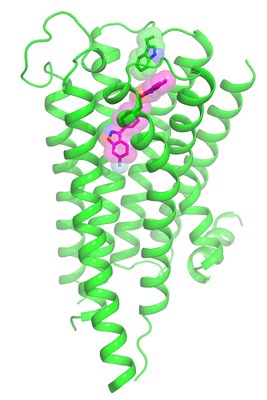Published in Nature, research from the lab of Bryan L. Roth, MD, PhD, Distinguished Professor of Pharmacology, revealed the first-ever crystal structure of the dopamine 2 receptor bound to an antipsychotic drug – a much-needed discovery in the quest to create effective drugs with fewer side effects to treat bipolar disorder, schizophrenia, and other conditions.

CHAPEL HILL, NC – Although antipsychotic drugs are among the most widely prescribed medications, individuals with schizophrenia, bipolar disorder and autism-spectrum disorders often experience severe side effects because the drugs interact with dozens of other brain receptors. Now, scientists at the UNC School of Medicine and UC San Francisco (UCSF) have solved the first high-resolution crystal structure of the dopamine 2 receptor (DRD2) bound to the antipsychotic drug risperidone, yielding a long-awaited tool for drug developers, psychiatrists, and neuroscientists.
The research, published in Nature, will allow researchers to selectively activate DRD2 thus potentially limiting a host of serious antipsychotic drug side effects such as weight gain, anxiety, dizziness, severe digestive problems, agitation, and many others.
“If we want to create better medications, the first step is to see what the D2 receptor looks like in high-resolution detail when it’s bound tightly to a drug,” said senior author Bryan L. Roth, MD, PhD, the Michael Hooker Distinguished Professor of Protein Therapeutics and Translational Proteomics at the UNC School of Medicine. “We now have the structure, and we’re exploring it to find new compounds we hope can help the millions of people in need of better treatments.”
~above excerpted from an article of the same title by Mark Derewicz on SOM News site – read the full article here…
read the journal article in Nature which details the technical challenges they overcame to get DRD2 to crystalize while bound tightly to risperidone – Structure of the D2 dopamine receptor bound to the atypical antipsychotic drug risperidone…
Roth lab postdoc, Sheng Wang, PhD, was first author on the paper. Roth lab postdocs, Daniel Wacker, PhD and Tao Che, PhD, also contributed to the paper.
